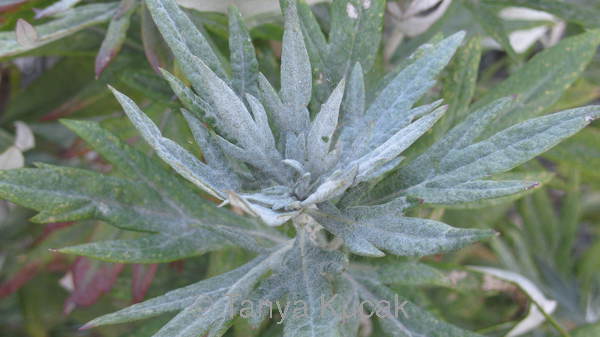
When I'm working in my garden late and the mosquitoes are biting, I usually rub an aromatic plant on my arms and face to minimize bites and keep welts from rising. But I recently learned how to make a simple bug spray using native plants, for those times when I'm away from my garden.
At a talk sponsored by the Gardening with Natives group of the California Native Plant Society, Alicia Funk said mugwort was an especially effective bug repellent. To make it, she fills a glass jar with the plants, pours boiling water over them, and lets them steep overnight. In the morning, she strains the overnight infusion and puts it in a spray bottle. Other plants that can be added to the mixture include California bay, mountain pennyroyal or coyote mint, yerba santa, or manzanita.
I'm delighted to find this practical use for mugwort, since it's a vigorous plant that needs to be cut back regularly to stay within bounds.
For poison oak, Funk makes a spray using manzanita leaves, in the same way: fill a jar with manzanita leaves, pour boiling water over them, let it steep overnight, and strain. Put the liquid in a spray bottle to use it. The astringency of the leaves dries up the rash and it's a very effective treatment, she said. Other plants that have been used to treat poison oak include mugwort, California bay,yerba santa, acorn shells,and grindelia.
Did you notice that bay, manzanita, and mugwort can be used in both formulas? One of the first things I noticed when I began studying herbs was that the same herbs seemed to be used for many different conditions, which made me think it was a scattershot approach. But as I learned more, I realized that this is a strength, because you can use what's available. For first-aid uses, often all you need is a certain property. For an insect repellent, you need aromatics that repel bugs. For poison oak, you need something that calms the itching or that's anti-inflammatory.To treat chronic medical conditions, however, you'd look for a unique combination of herbs to bring the system back into balance.
The all-purpose household cleaner Funk has used for the past four years is also an overnight infusion she makes from native plants. She uses California bay leaves and the bright-green tips of douglas fir branches, and adds distilled vinegar to the strained mixture. She puts it in a spray bottle and uses it to clean wood floors and disinfect countertops.
If you can boil water, Funk said, you can make these useful concoctions.But the most important skill is learning to recognize the plants.
Her 5-year-old knows about yarrow's antiseptic qualities. Whenever someone has a minor injury, instead of getting a band-aid he runs out to the garden to get some yarrow leaves. Lightly crushed and applied to a cut or scrape, the leaves stop the bleeding and quickly reduce pain. The most effective varieties are the native white or Island Pink yarrow.

Yarrow is a convenient and effective first-aid remedy in the garden. Crush a leaf and apply it to any cut or scrape for quick relief. You can also eat the young leaves in salads. The native white and 'Island Pink' varieties have the most medicinal value.

California bay leaves are twice as strong as Mediterranean bay leaves, so use half the amount given in recipes. For household and medicinal uses, you can make overnight infusions and dilute as needed.

Mugwort is too vigorous for a small garden, but too useful to leave out. The solution? Harvest it regularly to use as an insect repellent and in dream pillows.
© 2013 Tanya Kucak